Contents
- India, Pakistan spar over Indus water talks
- UNICEF on COVID-19 induced food insecurity
- Coronal magnetic field measured for the first time
- Studying P. vivax malaria
- Defence Ministry to impose import embargo
- Bamboo seed-bombs to tackle elephant problem
- Kozhikode plane crash: Tabletop Runway issue
- Reducing Imports from China
INDIA, PAKISTAN SPAR OVER INDUS WATER TALKS
Focus: GS-II International relations, GS-I Geography
Why in news?
India has refused a request by Pakistan to hold a meeting on issues around the Indus Water Treaty (IWT) as India had suggested a virtual conference but Pakistan had insisted on a physical meeting.
Details
- The practice at the IWT meetings is that they are led by Indus Water Commissioners from both countries and a range of issues on construction of dams and hydropower projects concerning the Indus river system are discussed.
- Among the key points on the table was evolving a procedure to solve differences on technical aspects governing the construction of the Ratle run-of-the-river (RoR) project on the Chenab in the Kishtwar district of Jammu and Kashmir.
- India has called for the appointment of a ‘neutral’ party while Pakistan favours a Court of Arbitration to agree upon a final resolution on the design parameters of this hydropower project.
Significant Points
- According to the terms of the IWT, India has the right to build RoR projects on the three ‘western’ rivers — the Chenab, Jhelum and Indus — provided it does so without substantially impeding water flow in Pakistan downstream.
- Pakistan believes that the project’s current design does pose a serious impediment and has told the World Bank that it wants a Court of Arbitration (CoA) set up to decide on the issue.
- India says this is only a technical issue and mutually solvable and has agreed to a ‘neutral party’ since a CoA potentially could stall any form of construction on all Indus projects.
Indus Waters Treaty (IWT)
- The Indus Waters Treaty is a water-distribution treaty between India and Pakistan, brokered by the World Bank, to use the water available in the Indus River and its tributaries.
- The Indus Waters Treaty (IWT) was signed in Karachi in 1960.
- The Treaty gives control over the waters of the three “eastern rivers” — the Beas, Ravi and Sutlej to India, while control over the waters of the three “western rivers” — the Indus, Chenab and Jhelum to Pakistan.
- India was allocated about 16% of the total water carried by the Indus system while Pakistan was allocated the remainder.
- The treaty allows India to use the Western River waters (the ones in Pakistan’s control) for limited irrigation use and unlimited non-consumptive use for such applications as power generation, navigation, floating of property, fish culture, etc.
- It lays down detailed regulations for India in building projects over the western rivers.
- The preamble of the treaty recognises the rights and obligations of each country in the optimum use of water from the Indus system in a spirit of goodwill, friendship and cooperation.
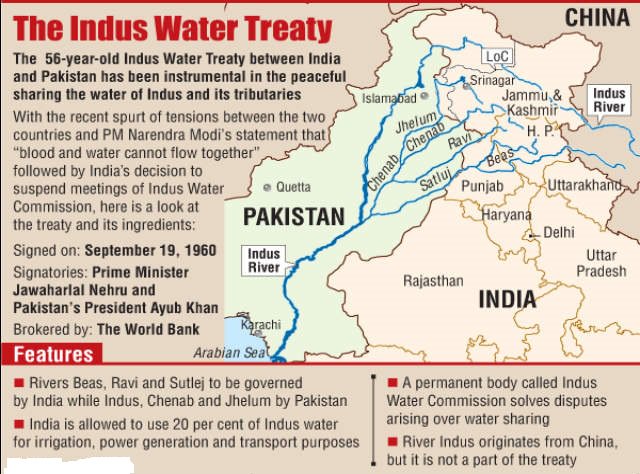
Indus River Basin
- The Indus River (also called the Sindhū) is one of the longest rivers in Asia and the longest river of Pakistan.
- It flows through China (western Tibet), India (Ladakh) and Pakistan.
- Its estimated annual flow is estimated to be twice that of the Nile River making it one of the largest rivers in the world in terms of annual flow.
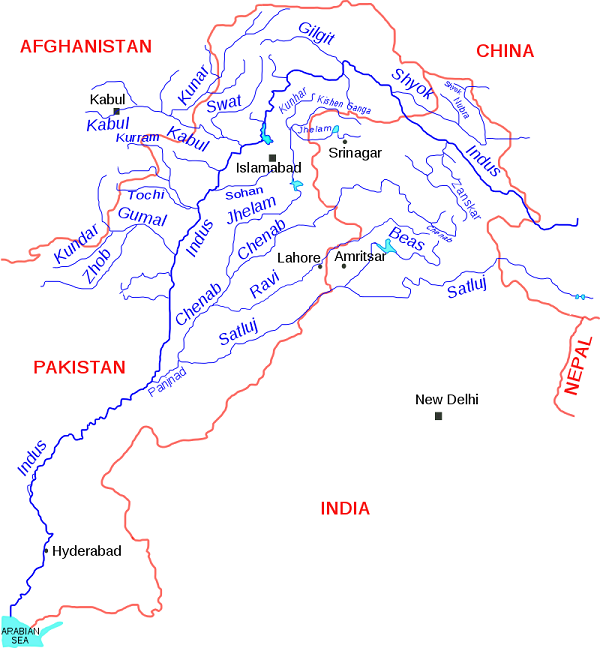
- The Zanskar is its left bank tributary in Ladakh.
- In the plains, its left bank tributary is the Panjnad which itself has five major tributaries, namely, the Chenab, Jhelum, the Ravi, the Beas, and the Sutlej.
- Its principal right bank tributaries are the Shyok, the Gilgit, the Kabul, the Gomal, and the Kurram.
-Source: The Hindu, Hindustan Times
UNICEF ON COVID-19 INDUCED FOOD INSECURITY
Focus: GS-II Social Justice
Why in news?
Increase in joblessness and poverty due to the pandemic will lead to a rise in hunger as well as malnutrition in the country, cautions UNICEF’s India Chief for Nutrition.
What has been the impact of COVID-19 on nutritional services?
- During the lockdown, in terms of distribution of foods, there was quick adaptability and there was also door-to door delivery of take-home ration (PKGKAY Scheme of providing free food-grains and pulses), but at the same time there were people on the move who could not be reached.
- Even though data is limited, it suggests the reach and coverage is still lagging behind.
- We need the same essential services, but need to deliver them through new platforms such that they do not contribute to possible spread of COVID-19.
What are the challenges India is facing vis-a-vis nutrition?
- According to a study of the more than 10 lakh under-5 deaths in India in 2017, almost 7 lakh deaths could be attributed to malnutrition.
- So, on an average, every day almost 2000 children under five die with malnutrition as underlying cause.
- Due to COVID-19 induced food security and malnutrition these figures will go up.
Nutritional Rehabilitation Centres (NRCs)
- Under National Health Mission (NHM), over 1000 NRCs have been established all across the country to provide facility-based care for children with Severe Acute Malnutrition (SAM) and medical complications.
As per National Family Health Survey (NFHS 4, 2015-16), 7.5% of under five children are severely wasted and more than 35% of children are underweight. - Children with Severe Acute Malnutrition (SAM) along with medical complications are referred from villages by frontline workers such ASHA and Anganwadi workers and admitted to NRCs as per the defined admission criteria.
- In order to improve their health condition, medical and nutritional therapeutic care is provided during NRC stay.
-Source: The Hindu
CORONAL MAGNETIC FIELD MEASURED FOR THE FIRST TIME
Focus: GS-III Science and Technology
Introduction
- The Sun is our closest star and we have been studying it for a long time, yet, it has many associated puzzles that are unexplained.
- A significant advancement has been made by an international team of solar physicists who have measured the global magnetic field of the Sun’s corona, or outer atmosphere, for the very first time.
India’s first solar mission, Aditya-L1 satellite will aim to measure the solar coronal magnetic fields regularly.

The solar puzzles
There are two main puzzles about the Sun which this advancement will help address:
- Coronal heating problem
- Mechanisms of eruptions of the Sun
Coronal Heating Problem
- Though the core of the Sun is at a temperature of about 15 million degrees, its outer layer, the photosphere is a mere 5700 degrees hot.
- However, its corona or outer atmosphere, which stretches up to several million kilometres beyond its surface, is much, much hotter than the surface (reaching temperatures of one million degrees or more).
Mechanisms of eruptions of the Sun
- Solar flares and coronal mass ejections (eruptions of the Sun) are driven by magnetic reconnections happening in the Sun’s corona.
- Magnetic reconnection is a process where oppositely polarity magnetic field lines connect and some of the magnetic energy is converted to heat energy and also kinetic energy which leads to the generation of heating, solar flares, solar jets, etc.
Details

- The team used a technique known as coronal seismology or magnetoseismology to measure the coronal magnetic field which has been known for a few decades.
- This method requires the measurement of the properties of magnetohydrodynamic (MHD) waves and the density of the corona simultaneously.
- The team used the improved measurements of the Coronal Multi-channel Polarimeter (CoMP) and advanced data analysis to measure the coronal magnetic field.
- It is very important to measure the corneal magnetic fields regularly since the solar corona is highly dynamic and varies within seconds to a minute time scale.
-Source: The Hindu
STUDYING P. VIVAX MALARIA
Focus: GS-III Science and Technology
Why in news?
- The parasite Plasmodium vivax, responsible for 7.5 million malaria cases worldwide, remains understudied.
- An international team has developed a system to breed these parasites in the lab and then infect cultured human liver cells with it.
How does vivax parasite work?
- Mosquitoes inject the sporozoite (spore-like) stage of the parasite into the skin when they bite, and the sporozoites travel to the liver.
- As the number is very low in the liver, our immune system barely notices it. This was believed to be a silent stage.
- In the liver cells it reproduces asexually producing thousands of merozoites which infect new red blood cells and initiate a cycle of reproduction and infection.
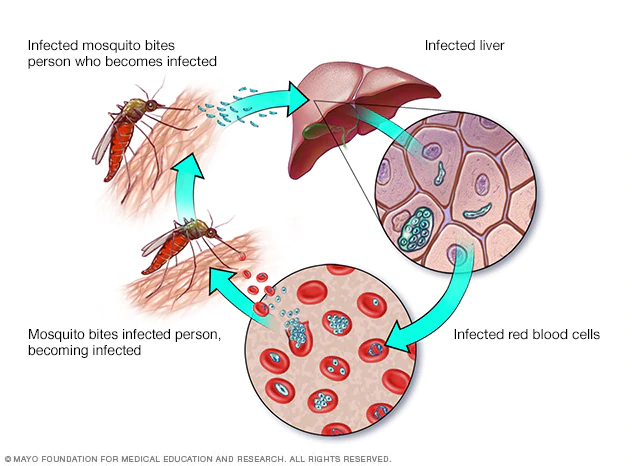
More about Malaria
- Malaria is a mosquito-borne infectious disease that affects humans and other animals.
- Malaria causes symptoms that typically include fever, tiredness, vomiting, and headaches and in severe cases it can cause yellow skin, seizures, coma, or death.
- Malaria is caused by single-celled microorganisms of the Plasmodium group. – (Neither Bacteria, nor Virus)
- The disease is most commonly spread by an infected female Anopheles mosquito.
- The risk of disease can be reduced by preventing mosquito bites through the use of mosquito nets and insect repellents, or with mosquito control measures such as spraying insecticides and draining standing water.
- The disease is widespread in the tropical and subtropical regions that exist in a broad band around the equator – This includes much of sub-Saharan Africa, Asia, and Latin America.
- One of the complications is the emergence of drug-resistant malaria parasites. Certain malaria-endemic countries have even abandoned chloroquine for P. vivax treatment. Fortunately, chloroquine is still effective in India.
-Source: The Hindu
DEFENCE MINISTRY TO IMPOSE IMPORT EMBARGO
Focus: GS-III Internal Security Challenges
Why in news?
The Defence Ministry will “introduce import embargo on 101 items beyond given timeline to boost indigenisation of defence production”.
Details
- The Ministry of Defence has prepared a list of 101 items for which there would be an embargo on the import beyond the timeline indicated against them.
- The government intends to reach a turnover of $25 billion through indigenously manufactured defence products and also expects to export products worth $5 billion.
- Government has also decided that in any government contract over ₹200 crore, no foreign company can participate in the tendering process, to help Indian Manufacturers.
- The embargo on imports is planned to be progressively implemented between 2020 to 2024.
- The aim is to apprise the Indian defence industry about the anticipated requirements of the Armed Forces so that they are better prepared to realise the goal of indigenisation.
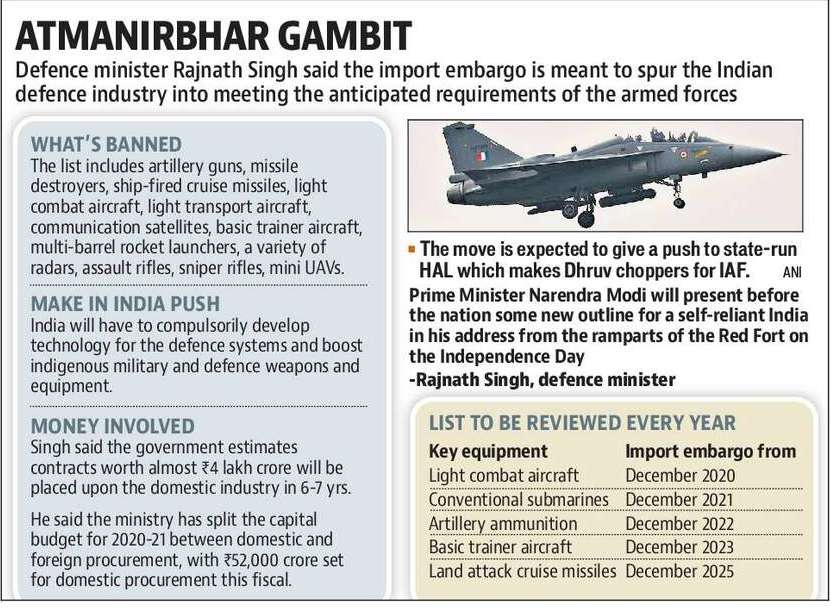
Click Here to read more about the Defence Production and Export Promotion Policy 2020 (DPEPP 2020)
-Source: The Hindu, Hindustan Times
BAMBOO SEED-BOMBS TO TACKLE ELEPHANT PROBLEM
Focus: GS-III Environment and Ecology
Why in news?
Encouraged by germination and subsequent growth in bamboo plantations, Odisha’s Athagarh Forest Division has begun casting seed balls inside different reserve forest areas to enrich food stock for wild elephants.
Details and How is it going to help?
- The growth in bamboo plantation is expected to meet the needs of the elephants, which often stray out of the forests and raid human habitations.
- Villagers who bear the brunt of the elephant attacks have come forward to prepare the bamboo seed balls and scatter them in the reserve forests.
- A vigorous monsoon with copious rains has helped the villagers and forest department personnel to ensure that the seed balls have germinated and taken root.
- For restoration of bamboo forests, a massive awareness campaign was launched in all the villages hit by elephant depredation.
- Villagers joined the campaign hoping to ensure the bamboo plants will keep the elephants in the forests rather than straying into their villages.
-Source: The Hindu
KOZHIKODE PLANE CRASH: TABLETOP RUNWAY ISSUE
Focus: GS-III Disaster Management
Why in news?
The crucial flight data recorder of the Air India Express flight AXB 1344 that crashed after overshooting the runway of Calicut International Airport at Karipur on Friday evening was recovered as investigations into the accident began.
Explanation given
- DGCA chief told that several recommendations in 2011 and 2019 to improve safety standards at the airport were complied with, though some suggestions such as extending the length of the runway could not be implemented due to lack of land availability.
- He clarified that the runway was sufficiently long for narrow body and wide body aircraft operations.
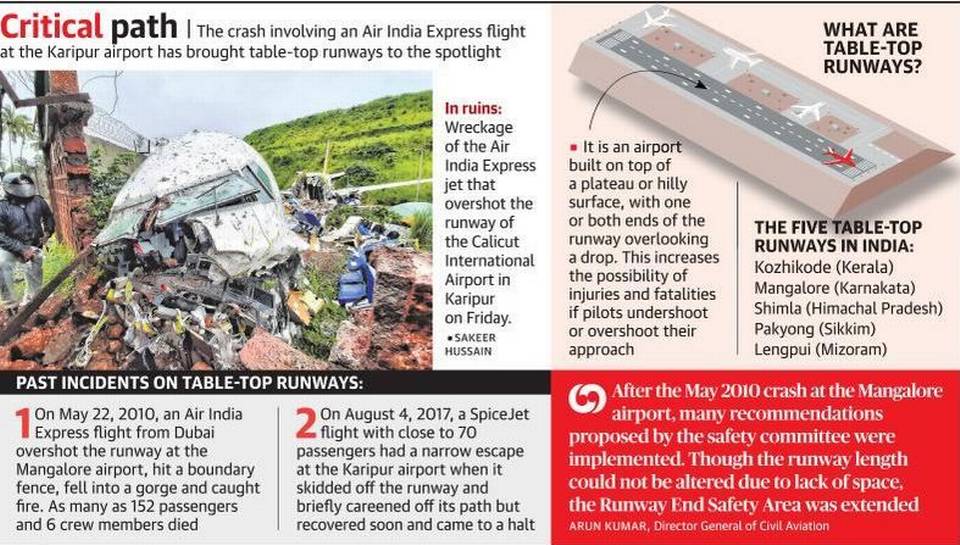
Tabletop runway problems
Tabletop runways do pose a challenge, but that challenge is factored in when they give clearance for commanders with a certain amount of experience
What is a tabletop runway?
- A tabletop runway is a runway that is located on the top of a plateau or hill with one or both ends adjacent to a steep precipice which drops into a deep gorge.
- This type of runway creates an optical illusion which requires a very precise approach by the pilot.
-Source: The Hindu
REDUCING IMPORTS FROM CHINA
Focus: GS-III Indian Economy
Why in news?
- According to a study – just 327 products — ranging from mobile phones and telecom equipment to cameras, solar panels, airconditioners and penicillin — accounted for nearly three fourths of the imports from China.
- The study also pointed out that it is possible to find alternative sources to get these goods or manufacture them in India.
Introduction
- In recent years, China has emerged as the hub for the production of electronics, pharma and chemicals with global giants setting up manufacturing facilities to not just cater to the domestic market but export to other destinations, including the US and Europe.
- Following the outbreak of Covid-19, several companies are looking at de-risking their production chains by setting up or relocating facilities to other countries.
Details
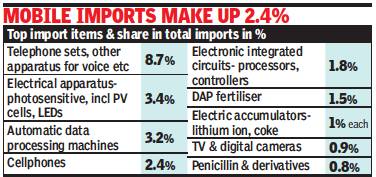
The study estimated the value of the “critically sensitive imports” at more than $65 billion in 2018 in overall imports of a little over $90 billion.
A product was considered sensitive if China accounted for over 10% share of imports or if the value of shipments was $50 million or more.
China not the most competitive producer in 82% imports: Study
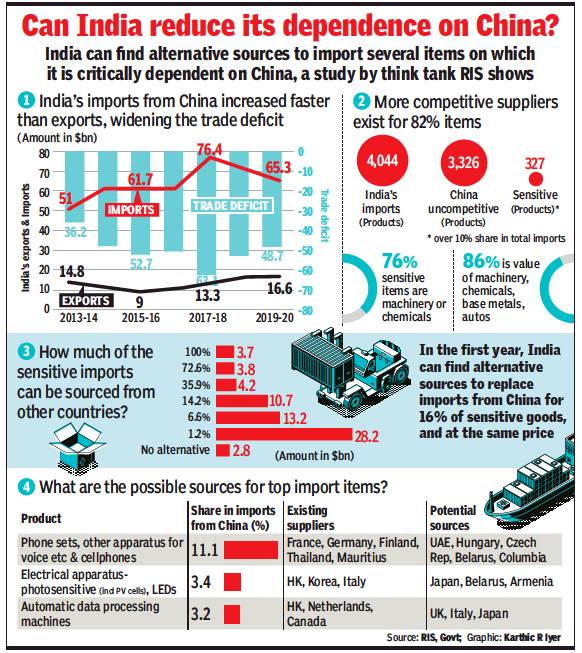
- In terms of the number of goods imported from across the border, the share of the 327 sensitive products was less than 10% of the items that were imported from China.
- The study estimated that in case of 82% products, China was not the most competitive producer.
- But there are also products where China is the sole exporter.
- It is possible to produce some of the products domestically if other sources are not immediately available.
-Source: Times of India




